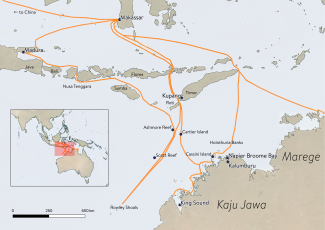Evidence of ancient sea crossings, many of which continue until today, can be found across Indonesia and Australia. People, including the first Australians, have been voyaging around the Indian Ocean for at least 60,000 years.
Great seaborne migrations of Austronesian peoples began around 5000 years ago. Later, exchange networks linked Southeast Asia to India and China, reaching as far as the Mediterranean. Evidence of long distance trade routes is found in the widespread cultivation of rice, dispersal of Dong Son culture of Vietnam and the recording of Moluccan cloves in China by the 3rd century BCE.
People were also constantly moving within Southeast Asia, with migrations by the Orang Laut (Strait of Melaka) and Bugis (Sulawesi) up until the 19th century.
Southeast Asian fishers
By the early 18th century, Makassans of the Kingdom of Gowa in Sulawesi plied a trade route between China and northern Australia. Using monsoon winds, they visited Kayu Jawa (Western Australia) and Marege (Northern Territory) to collect trepang (sea cucumber, Thelenota ananas), trochus and pearlshell, shark fin, turtle and clam meat. Crews included Bugis, Javanese, Ceramese, Sumbawese and Bajau people. Later vessels came from Kupang in West Timor and Roti.
In Marege, in particular, fishers formed enduring relationships with Aboriginal people some of whom returned to Makassar with the prau fleets. From Makassar the harvest was transported to China where the trepang were a prized delicacy used in soups and as an aphrodisiac.
